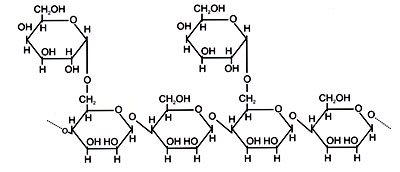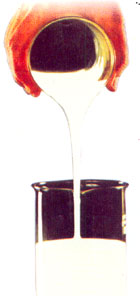|
|
 |
Guar Gum
(Botanical Name- Cyamopsis tetragonolobus) |
|
| Guar Gum Split |
Guar Gum Powder |
|
| Introduction |
|
Guar gum is derived from the ground endosperm of the guar plant. This ia a hardy and drought- resistant plant which grows 1-2m high with vertical stalks. The seed pods grow in clusters on the vertical stalks. The pods are about 15 cm. long and six to nine seeds about 2-3 mm. in diameter. Roughly, 14-16% of the seeds is the hull, 38-45% represent endosperm, and40-46% germ.
|
|
|
| Processing |
|
|
In commercial processing, a verity of methods are used to separate the guar endosperm from the hull and germ. The hull can be loosened by soaking in water and then removed by charring the hull by flame treatment. Then different grinding is used to separate the germ from the endosperm, since there is a difference in hardness
|
|
|
|
| Physical |
|
|
Guar Gum is practically odorless and has a bland taste. Its color is off-white to very light yellow tan. Mesh sizes are readily available from 40 to 300 BSS.
|
|
|
|
| Solubility |
|
|
Guar Gum will disperse and swell almost completely in cold or hot water. It is insoluble in organic solvent.
|
|
|
|
| pH Value |
|
|
A 1 % guar sol has a pH between pH 5 and 7. The optimum hydration rate occurs between pH 7.5 and 9. it has a very slight buffering action and is very stable from pH 4 to 10.5. The preferred method to prepare a sol having a very low or very high pH is to prepare a sol at the gum's normal pH and then adjust to as low as pH 1 or slightly above pH 10.5 to give stable sols.
|
|
|
|
| Chemical Characteristics |
|
|
Guar Gum, like locust bean gum, is a polysaccharide consisting of a straight chain of D--mannopyranose units joined by B *( 1-4) Linkages with a side branching unit of a single D-galactopyranose unit joined to every other mannose unit by a *(1-6) linkages. Locust bean gum has a single galactose side branch every fourth mannose unit. The molecular weight of guar is 220,000 +/-1 0%. The greater side-branching of guar accounts for its cold water hydration as well as its greater hydrogen-bonding activity. An average quality guar gum contains about 80% Galactomannan, 12% Water, 5% Protein, 2% acid insoluble residue or crude fiber, 0.7% Ash, 0.7% Fat, a trace of heavy metals, (arsenic and lead).
|
|
|
|
 |
| Chemical Composition Of Guar Gum |
|
|
| Viscosity |
|
|
The most important characteristic of Guar is its ability to be dispersed in water and hydrate or swell rapidly and almost completely in cold water to form viscous colloidal dispersions or sols. The viscosity attained is dependent on time, Temperature, concentration, pH, rate of agitation, and particle size of the powdered gum is used. The lower the temperature, the lower the rate at which viscosity increases, and the lower the final viscosity. Above 80c the final viscosity is slightly reduced. The finer guar powder swell more rapidly than coarse powdered gum.
|
 |
|
|
|
|
| Compatibility |
|
|
Guar gum, being a nonionic polymer, is compatible with most other hydrocolloids. It is compatible with most chemically modified starches, modified cellulose, synthetic polymers, and water soluble proteins. Guar is compatible with many salts over a wide range of electrolyte concentration. Some multivalent salts affect hydration and viscosity, and even produce gels. Borate on present in alkaline water inhibits the hydration.
|
|
|
|
|
|
|
If guar gum is hydrated, a cohesive structural gel may be formed by the borate ion at pH 7.5 to 10.5. This gel is reversible by reducing pH below 7 or by heating the gel. Polysaccharides, having numerous cis-hydroxyl groups, can form the three dimensional gel with pentavalent boron. The Guar borate gel may also be liquefied by addition of glycerol or mannitol, both low molecular-weight polyols.
|
|
|
|
|
|